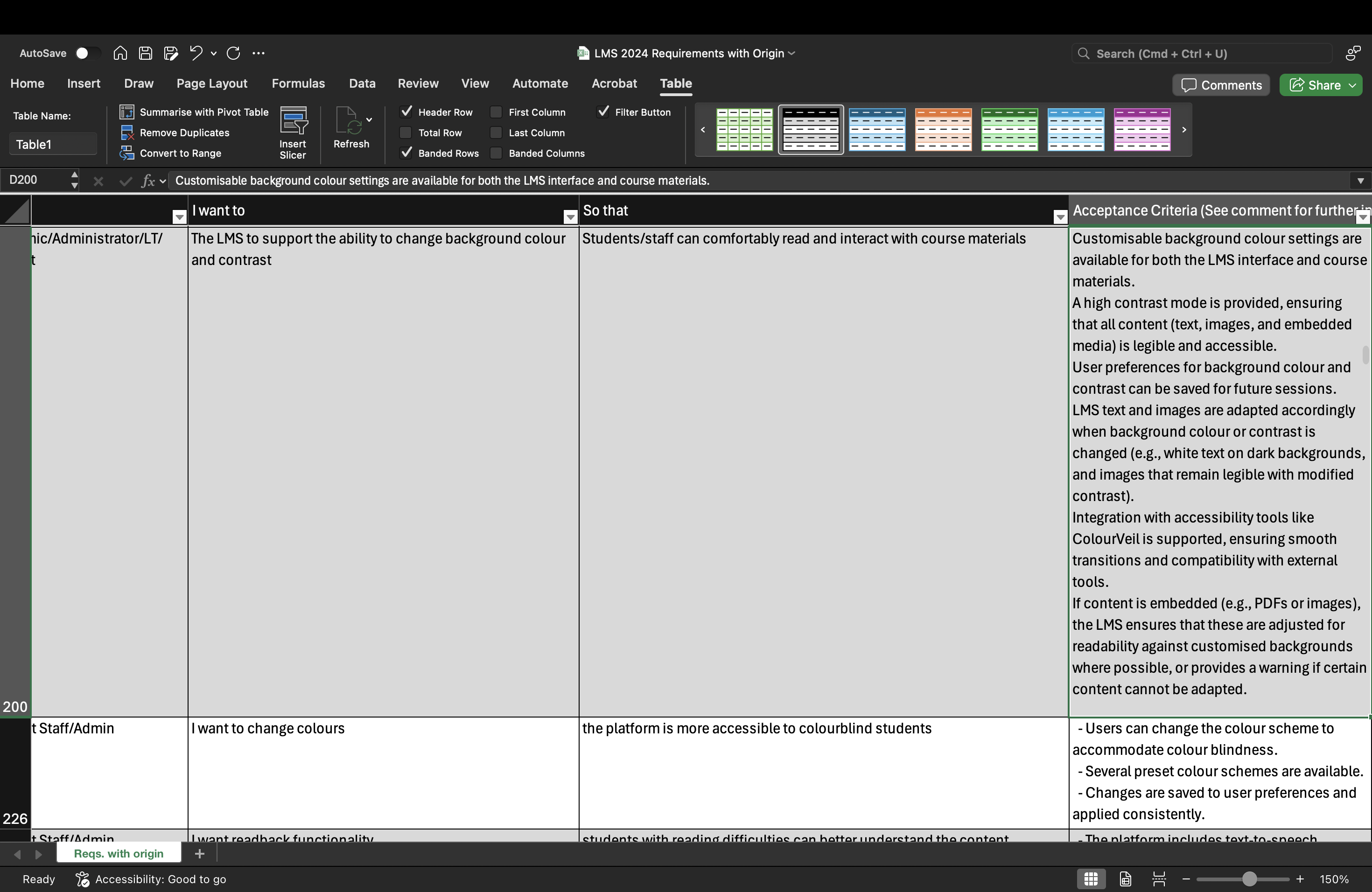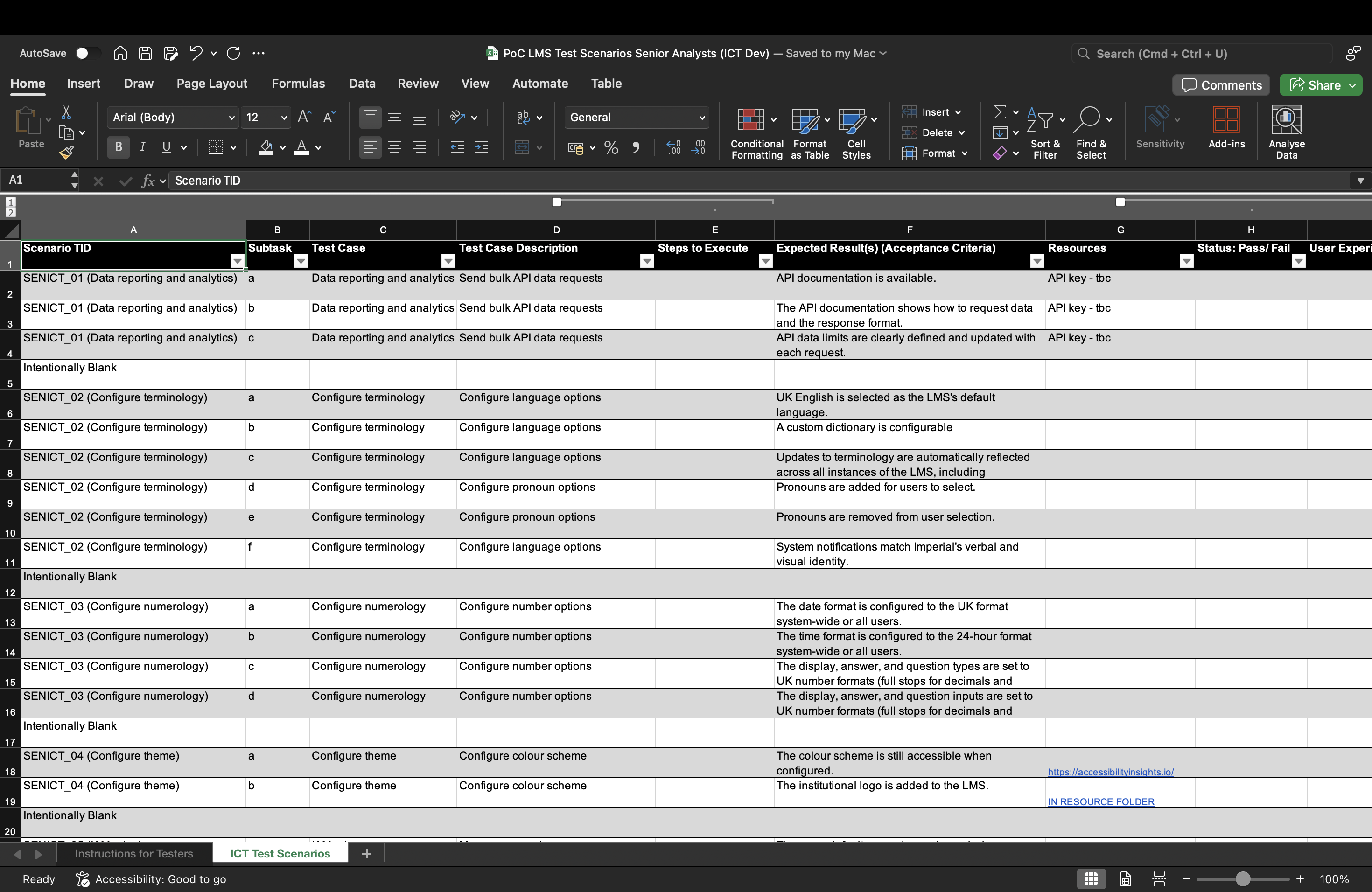Description
In my role as a Learning Technologist at Imperial College London, I have been part of a cross-functional team evaluating multiple LMS platforms (Blackboard Ultra, Brightspace, Canvas) to support a major institutional review. This required direct comparison of the platforms, evaluating their APIs, integration models, accessibility compliance (such as WCAG 2.1), and alignment with the pedagogical and administrative needs of various faculties.

Accessibility was a consistent priority across all faculties, but the Faculty of Natural Sciences and the Faculty of Medicine raised specific requirements around colour schemes and visual accessibility. To capture these needs, they developed detailed user stories with acceptance criteria. For example, requirements included configurable background colours, high-contrast modes, and support for colour-blind users through preset colour schemes.
We then had to decide which elements should be provided natively within the LMS and which could be supported through external tools such as ColourVeil. To justify this, we compared the degree to which each platform could natively preserve accessibility when colour schemes were customised. For instance, one LMS automatically adjusted text colour (to black or white) depending on the selected background, ensuring contrast ratios always remained accessible. This feature was judged particularly valuable as it reduced the reliance on external tools and prevented user error.
To ensure claims about accessibility could be validated, testers used Accessibility Insights to check that colour customisations met WCAG standards. Links to this testing resource were included directly in the evaluation scripts, making the process transparent and reproducible.

Alongside technical evaluation, I engaged with key stakeholders to manage change effectively, recognising that successful adoption depends on clear communication and aligning technology capabilities with user readiness.
To support the evaluation process more broadly, I developed a reusable Postman collection for testing Blackboard Ultra's APIs and authored detailed user stories to ensure the LMS evaluation process was grounded in real-world requirements. Additionally, I created structured manual test scripts to explore functionality limitations and prepared for future automation testing.
Through API testing and hands-on exploration, I found that achieving scalability and interoperability often involves compromises, such as reduced customisation or the need for greater investment in staff training and change management.
My approach to technology evaluation always considers the wider ecosystem and the technology's fitness for purpose, particularly how it will scale within complex educational settings and remain maintainable over time.
Reflection
My experience comparing these platforms highlighted that choosing between technologies is rarely straightforward, as each comes with trade-offs. For example, Blackboard Ultra offers deep API access and mature accessibility features, but its user interface feels more traditional compared to the cleaner, more modern UX design of Canvas and Brightspace. While Canvas and Brightspace provide flexible, cloud-native integration models and a more intuitive experience for end users, they may lack some of the institutional familiarity and long-standing accessibility tooling that Blackboard offers.
The accessibility case study around colour customisation highlighted how we dealt with multiple requirements by:
- capturing them in structured user stories and acceptance criteria,
- testing them using consistent methods and tools, and
- justifying choices by balancing native functionality against reliance on external tools.
In my technical work, I've found that automation with tools like Electron or Python/Pandas can offer enormous time savings, but also come with trade-offs in terms of long-term maintainability and user onboarding. This experience gave me confidence in evaluating trade-offs systematically, and I now approach new technology choices with a clearer sense of how to balance staff needs with long-term sustainability.
On review, these experiences have had a lasting impact on how I approach learning technology. I have become more confident in championing accessibility earlier in technology reviews, and in using structured methods like user stories and acceptance criteria to manage stakeholder needs. This has also shaped how I communicate with staff: I now place greater emphasis on showing how technical decisions (such as native vs external colour accessibility) directly affect teaching and learning, ensuring that staff understand both the benefits and the limitations of a platform.
For students, these evaluations make a tangible difference — for example, ensuring that colour customisation works natively in the LMS reduces barriers to engagement and supports inclusive teaching. Overall, I feel my practice has become more systematic, evidence-based, and confident as a result of my work on the Digital Education Platform Project (DEPP).
For staff, this process also provided reassurance that accessibility was prioritised from the outset, which strengthened trust in the evaluation and reduced the risk of accessibility being treated as an afterthought. Working with multiple faculties showed me that even when requirements differ, structured user stories provide a shared language. Overall, these experiences have made me more confident in leading evaluations where technical, pedagogical, and accessibility requirements must be balanced, and in articulating how those decisions directly affect both teaching and learning.
Summary
This section demonstrates how I have:
- Compared and contrasted multiple LMS platforms (Blackboard Ultra, Canvas, Brightspace) for APIs, integration models, accessibility features, and user experience
- Developed tools such as Postman collections, user stories, and manual test scripts to support evidence-based evaluation of technology choices
- Addressed multiple stakeholder requirements for accessibility by creating acceptance criteria, testing compliance, and justifying the inclusion of native vs external accessibility features
- Identified trade-offs between scalability, interoperability, and customisation when exploring LMS platforms and API functionality
- Considered constraints such as platform specificity, internal infrastructure, and offline access when developing automation tools
- Built a cross-platform Electron application that addressed team needs across macOS and Windows environments
- Evaluated technologies with attention to sustainability, value for money, and long-term maintainability
- Advocated for open standards (for example, REST, GraphQL, WCAG, EN301549) while recognising the internal capacity required to adopt and maintain them effectively
Evidence
Platform Evaluation & API Testing
- Postman collection developed from Blackboard Ultra's Swagger spec (Repository) Demonstrates critical evaluation of LMS API functionality and interoperability through hands-on testing; used to explore constraints and affordances of Blackboard Ultra's integration model.
- ICT Senior Analyst test script (Screenshot) Shows how structured manual test scripts were used to evaluate platform functionality, identify limitations, and simulate user journeys with reproducible steps.
- Digital Education Platform Project (DEPP) ICT Department Presentation (2024) (PDF) Captures the institutional evaluation context — multiple LMS platforms compared against timelines, accessibility, scalability, and integration requirements.
Accessibility & User-Centred Design
- Colour Accessibility User Stories (Screenshot) Evidence of user-centred requirements (acceptance criteria, contrast needs, preset schemes) informing evaluation and decision-making; demonstrates alignment with inclusive design principles.
Custom Tooling & Automation
- Trainee List Electron app (Screenshot) Shows custom tool development under infrastructure and access constraints; justifies cross-platform delivery and documents trade-offs between performance, maintainability, and scalability.
Further Reading
- Anthology Anthology REST API documentation. Available at developer.blackboard.com
- Anthology Blackboard Ultra. Available at anthology.com
- Atlassian Acceptance Criteria: Examples and Best Practices. Available at atlassian.com
- Carr, P. (2023). Digital Transformation 101: How to Choose the Right Technology. Available at engineering.com
- D2L Brightspace API Reference. Available at desire2learn.com
- D2L Brightspace by D2L. Available at d2l.com
- Instructure Canvas LMS. Available at instructure.com
- Instructure Canvas LMS API Documentation. Available at canvas.instructure.com
- ProductPlan MoSCoW Prioritization. Available at productplan.com
- Rehkopf, M. User Stories with Examples and a Template. Atlassian. Available at atlassian.com